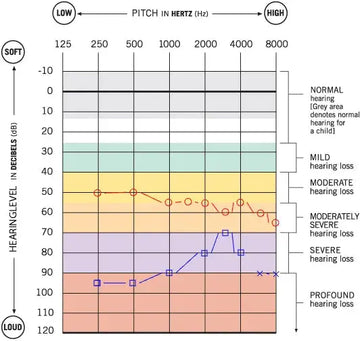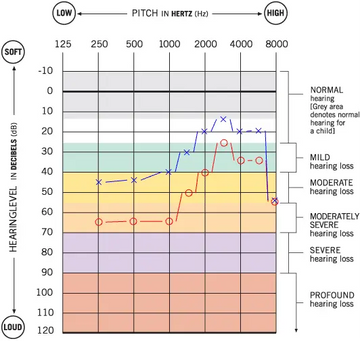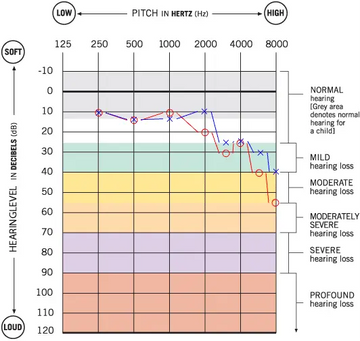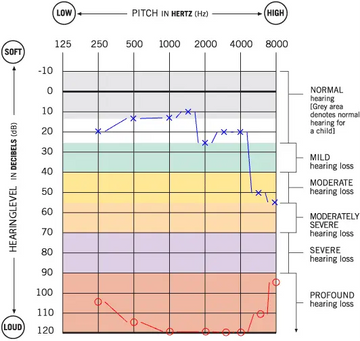Abstract
This case study details the audiological journey of Ms. Kanti*, a 71-year-old woman diagnosed with cholesteatoma in the Fall of 2024. Her hearing health history included six years of chronic ear infections, drainage, and progressive hearing loss, primarily in her left ear. Audiological management, including hearing aid fittings and adjustments, was provided in conjunction with her medical treatment. This study highlights the importance of collaborative care and patient-centered audiological management for chronic otologic diagnoses.
Introduction
Definition of Cholesteatoma:
Cholesteatoma is a type of abnormal skin growth that occurs in the middle ear or mastoid. It consists of skin-like tissue that produces keratin—a protein found in hair and nails—and can cause persistent infections and progressive hearing loss. Although it is not cancerous, cholesteatomas can lead to serious complications, such as damage to the ossicles (bones in the middle ear), balance problems, and, in rare cases, infections that spread to the brain.
Types of Cholesteatoma:
There are different types of cholesteatomas, but the most common are acquired and congenital. Acquired cholesteatoma develops due to chronic ear infections, eustachian tube dysfunction, or eardrum perforations. It can form when a retraction pocket traps skin cells or when skin enters the middle ear through an injury (Gopen, 2018; Alfonso, 2025).
Congenital cholesteatoma, on the other hand, is present at birth and results from trapped skin cells in the middle ear during fetal development. Unlike acquired cases, it occurs without a history of infections or eardrum damage (Bluestone & Bluestone, 2019; Alfonso, 2025). Both types can lead to serious complications, making early diagnosis and treatment critical.
Symptoms of Cholesteatoma:
Cholesteatoma can cause a range of symptoms beyond persistent ear drainage and hearing loss. Many people experience a feeling of fullness or pressure in the affected ear, as well as tinnitus, which can present as ringing, buzzing, or other sounds. In some cases, the condition may lead to dizziness or balance problems if the inner ear is affected.
Ear pain is also common, especially when an infection is present, and a strong, foul-smelling odor may come from the ear due to the buildup of infected debris. In rare cases, a cholesteatoma can grow large enough to press on the facial nerve, leading to weakness or even paralysis on one side of the face. If left untreated, the condition can cause serious complications, such as damage to the bones in the middle ear or even infections that spread to the brain. Early diagnosis and treatment are essential to prevent long-term harm.
Prevalence and Incidence of Cholesteatoma in the United States:
Cholesteatomas are relatively rare. The yearly occurrence of acquired cholesteatoma is estimated to be between nine and 13 cases per 100,000 adults and between three and 15 cases per 100,000 children (Alhazmi et al., 2023). The condition is slightly more prevalent in males than females and is most commonly diagnosed in adults, although it can occur in children. Congenital cholesteatomas are less common than acquired cholesteatomas, typically resulting from chronic otitis media or eustachian tube dysfunction (Gopen, 2018).
The prevalence of acquired cholesteatoma is higher among individuals with a history of recurrent ear infections, with the risk increasing in cases of untreated or poorly managed otitis media (ear infections). Early diagnosis and intervention are crucial to prevent complications (Rosenfeld et al., 2021).
Ms. Kanti’s Case History
Ms. Kanti, a 71-year-old woman, was first seen in the clinic in 2018 with a history of asymmetric hearing loss, chronic drainage, and persistent ear infections from her left ear. Audiological testing revealed moderate to severe sensorineural hearing loss in the right ear and profound to severe to profound mixed (conductive and sensorineural) hearing loss in the left ear.
Ms. Kanti’s 2018 Decibel Chart
At the time, Ms. Kanti used donated Phonak Naída S V SP BTE hearing aids coupled with custom silicone earmolds. She had been wearing these donated hearing aids for 4 to 5 years and expressed a desire to continue using them despite the challenges posed by her ongoing ear drainage and chronic infection.
During the appointment, her hearing aids were cleaned and adjusted to provide better listening comfort and improved speech understanding. It was noted that the left hearing aid could only be used for environmental awareness since the amount of amplification provided by the hearing aid was unable to provide full benefit for Ms. Kanti’s significant hearing loss in her left ear. It was recommended that Ms. Kanti receive a full medical evaluation for her chronic ear drainage and infection with her ENT physician.
Ms. Kanti’s’ Phonak Naida S V SP BTE Hearing Aids
Follow-Up and Hearing Aid Check:
Ms. Kanti returned to the clinic in 2021 for an updated audiological evaluation and hearing aid evaluation. She reported continuous drainage and recurrent ear infections, which occurred in the past year, and indicated she has had frequent visits to her ENT physician for treatment and management. Audiological testing revealed slight improvement in the left ear’s hearing sensitivity and stable hearing sensitivity in the right ear. During her hearing aid evaluation, Ms. Kanti reported that her Phonak hearing aids were no longer functioning properly due to technical issues, and has been without her hearing aids for almost a month.
Ms. Kanti’s 2021 Decibel Chart
A set of Unitron T Stride 600 BTE hearing aids was recommended for better listening comfort and to prevent further damage due to drainage and moisture build-up. Ms. Kanti returned to the clinic 3 weeks later to obtain her new hearing aids and new custom silicone earmolds. The hearing aids were later programmed to match Ms. Kanti’s hearing test, and she reported a good fit and comfort of her hearing aids.
Ms. Kanti’s hearing aids were verified using real-ear objective measures and validated for optimal performance during speech-understanding tasks. It was noted that the left ear continues to function for environmental awareness, whereas the right hearing aid helps provide speech clarity and listening comfort. Ms. Kanti expressed satisfaction with the new devices during follow-up visits.
Ms. Kanti’s Unitron T Stride 600 BTE Hearing Aid
Hearing Aid Follow-up and Audiological Updates:
In 2022, Ms. Kanti’s hearing health revealed continuous drainage of the left ear. Her hearing test results revealed decreased hearing sensitivity in her left ear when compared to her 2021 test results. She reported continuous visits and management of the left ear with her ENT physician. It was recommended she continue to receive medical care for her left ear with her ENT physician and to return to the clinic for a follow-up hearing test.
Ms. Kanti’s’ 2022 Decibel Chart
Ms. Kanti reported that she lost her Unitron BTE hearing aids while traveling overseas. She was able to receive a replacement set under her loss and damage replacement warranty. The replacement devices were later re-programmed to the current settings like her previous ones, and she was given instructions on how to care for them properly to help prevent future losses.
Continued Challenges and Progress:
In 2024, Ms. Kanti returned to the clinic for an updated hearing test and hearing aid check. She reported she lost her replacement Unitron BTE hearing aids again when traveling overseas but was able to receive a new set of hearing aids called Signia Motion SP BTEs coupled with new silicone earmolds, which she purchased from overseas. She expressed that she has been experiencing difficulty understanding speech with her new hearing aids. She reported significant challenges in noisy environments and noted that her left ear had started draining again and has been draining for the past two weeks. Upon examination, it was observed that there were signs of chronic drainage in the left ear. It was suggested she see her ENT physician for further evaluation, treatment and management.
Eight weeks later, the patient returned with a formal diagnosis of cholesteatoma in her left ear. The ENT physician recommended surgical intervention to remove the growth. However, the physician proceeded to medically clear Ms. Kanti to continue using hearing aids before the surgical procedure. It was recommended at the time to obtain a pre-op hearing exam to be reviewed by her ENT physician. Her pre-op hearing test revealed no significant improvement in the left hearing sensitivity and a slight decrease in the low frequency in the right ear when compared to her 2022 test results. Ms. Kanti reported later that she is scheduled for her surgical procedure in the early Spring of 2025. A post-op hearing test will be completed at a later time.
Ms. Kanti’s 2024 Decibel Chart
At this visit, Ms. Kanti wore Signia Motion SP BTE hearing aids, which were purchased overseas. Her hearing aids were adjusted to improve speech clarity and listening comfort on the right side and listening comfort for environmental awareness on the left side. Ms. Kanti was counseled on the importance of regular and continuous medical follow-ups to monitor the cholesteatoma and prevent further complications.
Ms. Kanti’s Signia Motion SP BTE Hearing Aids
Positive Impact of Ongoing Hearing Health and Hearing Aid Care:
Managing Ms. Kanti’s hearing needs was challenging due to mild changes in her hearing levels, recurring infections, and frequent loss of her hearing aids and hearing aid malfunctions. Regular follow-ups were essential to monitor her hearing status and make necessary adjustments to her devices. Ms. Kanti’s hearing aids required frequent reprogramming to accommodate changes in her hearing sensitivity, and custom earmolds were necessary to manage drainage and improve comfort. Patient education was also key, ensuring she knew how to care for her hearing aids and avoid losing them. With ongoing audiological support and coordination with her medical team, Ms. Kanti was able to maintain her hearing and improve her daily communication.
Conclusion
This case highlights the challenges of managing hearing loss in patients with chronic ear conditions like cholesteatoma. It demonstrates the importance of collaboration between audiologists and medical professionals to provide well-rounded care. Regular hearing tests, hearing aid adjustments, and timely medical treatment played a key role in preserving the patient’s hearing and overall quality of life.
A patient-centered approach was crucial in meeting her specific needs, including her desire to keep using hearing aids despite ongoing ear drainage. This case also stresses the value of patient education, especially in maintaining and properly using hearing aids to achieve the best possible results.
As research continues to improve our understanding of cholesteatoma and its effects on hearing, it is important to develop evidence-based care strategies that integrate both medical and audiological management. This will help ensure that patients with complex conditions receive effective and personalized treatment.
Audiologist's Takeaway
This case highlights the importance of adaptability and collaboration in managing patients with chronic ear conditions. Ms. Kanti’s mild fluctuating hearing and recurrent drainage made it difficult for her to consistently wear her hearing aids. To address this, silicone custom earmolds were used to improve comfort when drainage occurred. She was also counseled on the importance of cleaning the molds daily to maintain hygiene and prevent further complications.
If there were an opportunity to do things differently, scheduling a hearing test every six months would have been ideal for closely monitoring any changes in Ms. Kanti’s hearing sensitivity. However, her frequent travel made it challenging for her to visit the clinic regularly. Despite this, it was essential for her to continue medical management and not skip ENT appointments, even when she had no active drainage, to prevent further complications.
This case underscores the need for patient education, particularly on the importance of consistent medical follow-ups and proper hearing aid care. While audiological management played a crucial role, ongoing coordination with her ENT physician ensured that her medical needs were also addressed. A patient-centered approach that integrates both audiological and medical care is key to effectively managing complex conditions like cholesteatoma.
References:
1. Alfonso K. P. (2025). Congenital Cholesteatoma. Otolaryngologic clinics of North America, 58(1), 65–74. https://doi.org/10.1016/j.otc.2024.07.023
2. Alhazmi, W. A., Al Mansour, M. H., Aljasser, R. I., Alanazi, A. M., Alyami, S. D., Almutairi, A. B., & Al Sulaiman, I. N. (2023). A Brief Review of Demographic and Clinical Correlates of Cholesteatoma Surgery in the Qassim Region. Cureus, 15(3), e35676. https://doi.org/10.7759/cureus.35676
3. Bluestone, C. D., & Bluestone, M. B. (2019). Pediatric otolaryngology. Elsevier Health Sciences.
4. Gopen, Q. (2018). Pathophysiology and clinical features of cholesteatoma. Clinical Otology Journal, 25(2), 95–102. https://doi.org/10.1097/MOO.0000000000000500
5. Rosenfeld, R. M., Schwartz, S. R., & Pynnonen, M. A. (2021). Clinical practice guideline: Cholesteatoma. Otolaryngology—Head and Neck Surgery, 164(4), S1–S20. https://doi.org/10.1177/01945998211021218
6. Sanna, M., Russo, A., & Taibah, A. (2020). Cholesteatoma and Ear Surgery. Thieme Medical Publishers.
***Please Note: To safeguard the individual's privacy, the name has been changed in this article.
***Disclaimer: The content presented here serves general informational purposes and is not intended as professional advice or a replacement for medical consultation. It is essential to seek personalized guidance and assistance from a qualified physician or hearing healthcare provider for any specific questions, concerns, or individual health conditions related to hearing. A professional in the field can offer a comprehensive evaluation and suitable recommendations based on your unique circumstances. Ignoring or postponing seeking medical or professional help may have negative impacts on your health. Always consult with a healthcare professional for precise diagnosis, appropriate treatment, and personalized advice concerning your hearing health.***





